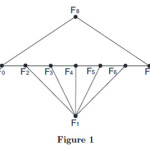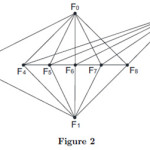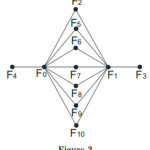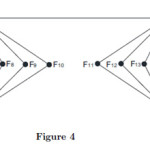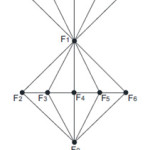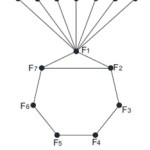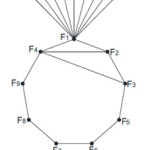Introduction
The idea of Fibonacci cordial labeling was given by A. H. Rokad and G. V. Ghodasara.1 The graphs which i considered here are Simple, undirected, connected and finite. Here V(G) and E(G) denotes the set of vertices and set of edges of a graph G respectively. For different graph theoretic symbols and nomenclature i refer Gross and Yellen.3 A dynamic survey of labeling of graphs is released and modified every year by Gallian.4
Definition 1
Let G = (V(G), E(G)) be a graph with V = X1∪X2∪X3∪. . . Xi∪Y
where each X i is a set of vertices having at least two vertices of the same degree
and Y=V\∪Xi.The degree splitting graph of G designated by DS (G) is acquired from G by adding vertices z1,z2, z3,. . . , zy and joining to each vertex of xi for i £[1, t].
Definition 2
The double fan DFn comprises of two fan graph that have a common path. In other words DFn = Pn+ K2
Definition 3
The duplication of an edge e= xy of graph G produces a new graph G’by adding an edge e’= x’y ’such that N(x’)=N(x)∪{y’}−{y}and N(y’)=N(y)∪{x’}−{x}.
Definition 4
The graph obtained by connecting a vertex of first copy of a graph G with a vertex of second copy of a graph G is called joint sum of two copies of G.
Definition 5
A globe is a graph obtained from two isolated vertex are joined by n paths of length two.It is denoted by Gl(n).
Definition 6
Ring sum G1⊕ G2of two graphs G1= (V1, E1) and G2= (V2, E2) is the graph G1⊕ G2= (V1∪ V2, (E1∪ E2) − (E1∩ E2)).
Results
Theorem 1
DS (Pn) is Fibonacci cordial.
Proof 1
Consider Pn with V (Pn) = {vi: i [1, n]}. Here V (Pn) = X1∪ X2, where X1= {xi: 2 [2, n-1]} and X2= {x1, xn}. To get DS(Pn) from G we add w1 and w2 corresponding to X1 and X2. Then
|V(DS (Pn))|=n+2 and E(DS (Pn))={X1w2, X2w2} ∪ {w1xi:i [2,n–1]}. So,|E(DS(Pn))|=−1 + 2n.
I determine labeling function g: V(G) → {F0, F1, F2, . . . , Fn+2} as below:
g(w1)= F1,
g (w2)= Fn+1,
g(x1)= F0,
g(xi) = Fi, 2 ≤ i ≤ n.
Therefore, |eg(1)−eg(0)|≤1.
Therefore, DS (Pn) is a Fibonacci cordial graph.
Example 1
Fibonacci cordial labeling of DS (P7) can be seen in Figure 1.
Theorem 2
DS (DFn) is a Fibonacci cordial graph.
Proof 2
Let G= Dfn be the double fan. Let x1, x 2,…, x n be the path vertices of Dfn and x and y be two apex vertices. To get DS(Dfn) from G,we add w1, w2 corresponding to X1, X2,where
X1={xi: i [1, n] }and X2= {x, y}.Then|V(DS(Dfn))| = 4+ n&E(DS(Dfn)) ={xw2, y w2}∪{xiw1: i [1, n] }. So,|E(DS(Dfn))|= 1+ 4n.
I determine labeling function g:V(G)→{F0,F1,F2,…,Fn+4},as below.
For all 1 ≤ i ≤n.
g (w1) = F3,
g(w2) = F2.
g(x) = F0,
g (y) = F1,
g(xi) = Fi+3.
Therefore |eg(1)−eg(0)|≤1.
Therefore, DS(DFn) is Fibonacci cordial.
Example 2
Fibonacci cordial labeling of DS(DF5) can be seen in Figure 2
Theorem 3
The graph obtained by duplication of an edge in K1, n is a Fibonacci cordial graph.
Proof 3
Let x0 be the apex vertex and x 1, x 2,…, x n be the consecutive pendant vertices of K1, n.Let G be the graph obtained by duplication of the edge e= x 0 x n by an e wedge e’= x0’xn’. There for e in G,deg(x0) = n,deg(x0’) = n,deg(vn) = 1, deg(xn’) = 1 and deg(xi) = 2,∀ i∈{1,2,…n}. Then|V(K1, n)| =n+3 and E(K1, n) =2n.
I determine labeling function g: V(G) → {F0, F1, F2, . . . , Fn+3}, as below.
g(x0)= F1,
g (x1) = F2,
g(xn−1)=F3,
g(x0’)=F0,
g(xn’)=F4,
g(xi)=Fi+3, i [2,n],in−1.
Therefore |eg(1)−eg(0)|≤1.
Therefore,the graph obtained by duplication of an edge in K1, n is a Fibonacci cordial graph.
Example 3
A Fibonacci cordial labeling of the graph obtained by duplication of an edge e in K1, 8 can be seen in the Figure 3.
Theorem 4
The graph obtained by joint sum of two copies of Globe Gl(n) is Fibonacci cordial.
Proof 4
Let G be the joint sum of two copies of Gl (n).Let{x, x’, x1, x 2,…, x n} and
{y, y ’, y1, y 2,…, y n} be the vertices of first and second copy of Gl(n)respectively.
I determine labeling function g: V(G) → {F0, F1, F2, . . . , F2n+4}, as below.
g(x) = F0,
g(x’)= F1,
g(xi)=Fi+3,i [1, n].
g(y)=F2,
g(y’)= F3,
g(yi) = Fn+i+3, i [1, n].
From the above labeling pattern i have eg (0)=n+1 and eg(1)=n.
Therefore |eg(1)−eg(0)|≤1.
Thus, the graph obtained by joint sum of two copies of Globe G l(n)is Fibonacci cordial.
Example 4
Fibonacci cordial labeling of the joint sum of two copies of Globe Gl(7) can be seen in Figure 4
Theorem 5
The graph DFn⊕ K1, n is a Fibonacci cordial graph for every n ∈ N .
Proof 5
Assume V(DFn⊕K1, n)= X1∪ X 2, where X1={x,w, x 1, x 2,…, x n} be the vertex set of DFn and X2={y=w, y 1, y 2,…, y n} is the vertex set of K1, n. Here v is the apex vertex & y 1, y 2,…, y n are pendant vertices of K1, n.
Also |V (DFn ⊕ K1,n)| = 2n + 2, |E(DFn ⊕ K1,n)| = 4n − 1.
I determine labeling function g:V(DFn⊕K1, n)→{F0,F1,F2,…,F2n+2},as below.
For all 1≤i≤n.
g (x)=F0,
g (w)=F1,
g(xi) = Fi+1,
g (yi) = Fn+i+1,
From the above labeling pattern i have eg(0) = 2n and eg(1) = 2n−1.
Therefore||e g(1)−eg(0)|≤1.
Thus, the graph DFn⊕ K1, n is a Fibonacci cordial graph for every n ∈ N .
Example 5
Fibonacci cordial labeling of DF5⊕ K1, 5 can be seen in Figure 5.
Theorem 6
The graph G ⊕ K1, n is a Fibonacci cordial graph for all n ≥4, n∈N,where G is the cycle Cn with one chord forming a triangle with two edges of Cn.
Proof 6
Let G be the cycle Cn with one chord. Let V (G ⊕ K1, n) = X1∪ X 2, where X 1 is the vertex set of G & X2 is the vertex set of K1, n. Let x 1, x 2,…, x n be the successive vertices of Cn and e= x 2 xn be the chord of Cn. The vertices x1, x 2, x n forma triangle with the chorde. Here v is the a pex vertex & y 1, y 2,…, y n are pendant vertices of K1, n.
I determine labeling function g: V (G ⊕K1, n) → {F0, F1,F2,. . . , F2n}, as below.
Case I: n≡0(mod3).
For all 1 ≤ i ≤ n.
g (xi) =Fi.
g(yi) = Fn+i.
Case II:n≡1(mod3).
g (xi) = Fi, 1 ≤ i ≤ n.
g (y1) = F0,
g(yi) = Fn+i−1, 2 ≤ i ≤ n.
From the above labeling pattern i have eg(0)=n and eg(1)=n+1.
Therefore |eg(1)−eg(0)|≤1.
Thus, the graph G ⊕ K1, nis a Fibonacci cordial graph.
Example 6
A Fibonacci cordial labeling of ring sum of C7 with one chord and
K1, 7 can be seen in Figure 6.
Theorem 7
The graph G ⊕ K1, n is a Fibonacci cordial graph for all n ≥5, n∈N,where G is the cycle with twin chords forming two triangles and another cycle Cn−2 with the edges of Cn.
Proof 7
Let G be the cycle Cn with twin chords,where chords form two triangles and one cycle Cn−2. Let V(G⊕K1, n)= X1∪ X 2. X1={x1, x 2,…, x n} is the vertex set of Cn, e1= xn x2 and e2= xn x3 are the chords of Cn. X2={y= x1, y1, y2,…, yn} is the vertex set of K1, n,where y1, y2,…, yn are pendant vertices and y= x1 is the apex vertex of K1, n. Also|V(G⊕K1, n)|=2n, |E(G ⊕ K1, n)| = 2n + 2.
Take y= x 1.Also|V(G⊕K1, n)|=2n, |E(G ⊕ K1,n)| = 2n + 1.
I determine labeling function g: V(G ⊕K1, n) → {F0, F1,F2,. . . , F2n}, as below.
g (x1)= F1,
g(x2)= F2,
g (x3)= F3,
g (xn) = F4,
g (xi) = Fi+1, 4 ≤ i ≤ n − 1.
g (yi) = Fn+i, 1 ≤ i ≤ n.
From the above labeling pattern i have eg (0)=eg(1)=n+1.
Therefore |eg(1)−eg(0)|≤1.
Thus, The graph G ⊕ K1, n is a Fibonacci cordial graph.
Example 7
A Fibonacci cordial labeling of ring sum of C9 with twin chords and K1, 9 can be seen in Figure 7.
Conclusion
In this paper i investigate seven new graph which admits Fibonacci cordial labeling.
Acknowledgement
The authors are highly thankful to the anonymous referee for kind comments and constructive suggestions.
References
- A. H. Rokad and G. V. Ghodasara, Fibonacci Cordial Labeling of Some Special Graphs.Annals of Pure and Applied Mathematics.2016;11(1)133−144.
- F. Harary,Graph theory, Addision-wesley, Reading,MA. 1969.
- J Gross and J. Yellen, Handbook of graph theory, CRC press. 2004.
- J. A. Gallian, A dynamic survey of graph labeling. The Electronics Journal of Combinatorics. 2012;19: DS61−260.
- M. Sundaram, R. Ponraj, and S. Somasundram, Prime cordial labeling of graphs. Journal of Indian Acadamy of Mathematics.2005;27:373-390.
- M. A. Seoud and M. A. Salim, Two upper bounds of prime cordial graphs. Journal of Combinatorial Mathematics and Combinatorial Computing.2010;75:95-103.
- S. K. Vaidya and P. L. Vihol, Prime cordial labeling for some cycle related graphs. International Journal of Open Problems in Computer Science Mathematics.2010;3(5):223-232.
- S. K. Vaidya and P. L. Vihol. Prime cordial labeling for some graphs. Modern Applied Science. 2010;4(8):
119-126.
CrossRef
- S. K. Vaidya and N. H. Shah, Prime cordial labeling of some graphs. Open Journal of Discrete Mathematics. 2012;2(1):11-16. doi:10.4236/ojdm.2012.21003.
CrossRef
- S. K. Vaidyaa and N. H. Shah, Prime cordial labeling of some wheel related graphs. Malaya Journal of Matematik.2013;4(1):148156.
Views: 1,588

This work is licensed under a Creative Commons Attribution 4.0 International License.

